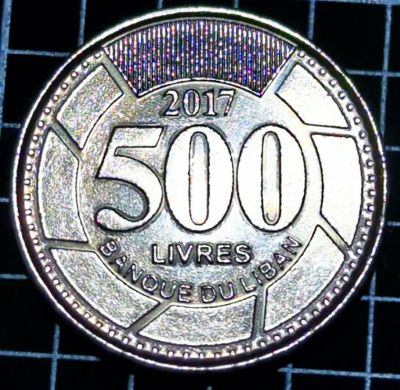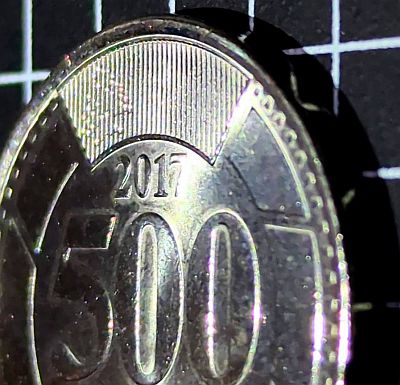A modern Stainless steel-clad iron coin
Obverse

When looking at the earlier 1936 Lebanon 5 Piastres, one of the prominent designs on the coin was the Lebanese Cedar Tree. Fast forward 80 years, and that is still the case. The tree on this coin is slightly more abstract and silhouette, but still clearly recognisable. The rest of the design on this side of the coin is in Arabic and translates to four lines which read: “Bank of Lebanon”, “500”, “Livres”, “2017”.
Reverse

The reverse contains the same textual information as the obverse, this time in French, and with a geometric pattern border rather than the tree behind the text. At the top of the coin is a latent image. Similar to that on the Taiwanese coin featured awhile ago, the latent image changes depending on the angle you look at the coin. It shows two cedar trees, one seen from each side. It was particularly hard to photograph, but you can just about make out the left side tree in this image:

Metal
The other interesting thing about this coin is the metal. It is the most recent coin made with iron. But it is not just Iron, but rather “Stainless Steel-clad Iron”. According to the Royal Society of Chemistry, Iron is the 26th element in the period table, discovered approximately 3,500 B.C.:
“Iron is an enigma – it rusts easily, yet it is the most important of all metals. 90% of all metal that is refined today is iron.
Most is used to manufacture steel, used in civil engineering (reinforced concrete, girders etc) and in manufacturing.
There are many different types of steel with different properties and uses. Ordinary carbon steel is an alloy of iron with carbon (from 0.1% for mild steel up to 2% for high carbon steels), with small amounts of other elements.
Alloy steels are carbon steels with other additives such as nickel, chromium, vanadium, tungsten and manganese. These are stronger and tougher than carbon steels and have a huge variety of applications including bridges, electricity pylons, bicycle chains, cutting tools and rifle barrels.
Stainless steel is very resistant to corrosion. It contains at least 10.5% chromium. Other metals such as nickel, molybdenum, titanium and copper are added to enhance its strength and workability. It is used in architecture, bearings, cutlery, surgical instruments and jewellery.
Cast iron contains 3–5% carbon. It is used for pipes, valves and pumps. It is not as tough as steel, but it is cheaper. Magnets can be made of iron and its alloys and compounds.”
And if you’d like to know more about Stainless Steel, ThermoFisher Scientific has a site with more info.
So, back to coins, in fact, there were four coins minted in 2017 of a similar “Stainless steel-clad iron” composition, from Lebanon, Malawi and Tajikistan. If we instead look at steel, in the last five years (2019 – 2024) there have been at least 496 coins incorporating that refined metal, and another 61 if we specify Stainless Steel. There have been plenty of steel coins issued in recent year, just not so many using pure iron.
And the last coins to use ONLY pure iron? We have to go back to the aftermath of WWII for that. This question popped into my head after covering the 1942 Sweden 5 Öre which was Iron. Those coins were minted through to 1950, as were a number of other Scandinavian and other country’s coins. Finland was the last holdout, using pure iron up until 1953, and switching to Nickel-Plated Iron until 1962


Leave a Reply